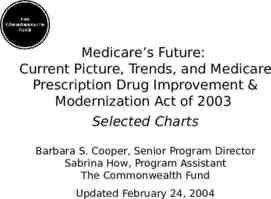Chapter 35 Intravenous Medications Copyright © 2009 Wolters
21 Slides3.12 MB
Chapter 35 Intravenous Medications Copyright 2009 Wolters Kluwer Health Lippincott Williams & Wilkins
Question Is the following statement true or false? The intravenous (IV) route of drug administration is considered the most dangerous route. Copyright 2009 Wolters Kluwer Health Lippincott Williams & Wilkins
Answer True. The intravenous (IV) route of drug administration is considered the most dangerous route. Copyright 2009 Wolters Kluwer Health Lippincott Williams & Wilkins
Intravenous Medication Administration Intravenous (IV) route: administration via peripheral and central veins is immediately effective and the most dangerous Situations for administering IV: – Clients have disorders affecting the absorption or metabolism of drugs – Quick response is needed during an emergency Copyright 2009 Wolters Kluwer Health Lippincott Williams & Wilkins
Intravenous Medication Administration (cont’d) Situations for administering IV (cont’d): – Blood levels of drugs must be maintained at a consistent therapeutic level – Client wants to avoid repeated painful intramuscular injections – A mechanism is needed to administer drug therapy over a prolonged period, as with cancer Copyright 2009 Wolters Kluwer Health Lippincott Williams & Wilkins
Administering Medications Through an Intravenous Port Copyright 2009 Wolters Kluwer Health Lippincott Williams & Wilkins
Intravenous Medication Administration (cont’d) Continuous administration: continuous drip; adding medication to a large volume Intermittent administration: short-term parenteral administration of medication – 3 types: bolus and secondary administration and volume-control set Copyright 2009 Wolters Kluwer Health Lippincott Williams & Wilkins
Intravenous Medication Administration (cont’d) Intermittent administration (cont’d) – Bolus administration: undiluted medication given quickly into a vein o Using an IV port: extends from the IV tubing o Using a medication lock: allows instant access to the venous system Copyright 2009 Wolters Kluwer Health Lippincott Williams & Wilkins
Administering Medications Through a Lock Copyright 2009 Wolters Kluwer Health Lippincott Williams & Wilkins
Medication Lock Copyright 2009 Wolters Kluwer Health Lippincott Williams & Wilkins
Intravenous Medication Administration (cont’d) Intermittent administration (cont’d) – Secondary infusions: administration of a parenteral drug that is diluted in a small volume of IV solution – Volume-control set: chamber in IV tubing that holds a portion of the solution from a larger container Copyright 2009 Wolters Kluwer Health Lippincott Williams & Wilkins
Piggyback Arrangement Copyright 2009 Wolters Kluwer Health Lippincott Williams & Wilkins
Volume-Control Set Copyright 2009 Wolters Kluwer Health Lippincott Williams & Wilkins
Question Which of the following involves the administration of a parenteral drug that has been diluted in a small volume of IV? a. Continuous administration b. Bolus administration c. Secondary infusion d. Volume-control set Copyright 2009 Wolters Kluwer Health Lippincott Williams & Wilkins
Central Venous Catheters Administer parenteral medication in a large volume of blood when: – Clients require long-term IV fluid – IV medications are irritating to peripheral veins – It is difficult to insert or maintain a peripherally inserted catheter Copyright 2009 Wolters Kluwer Health Lippincott Williams & Wilkins
Using a Central Venous Catheter Copyright 2009 Wolters Kluwer Health Lippincott Williams & Wilkins
Central Venous Catheters (cont’d) Percutaneous catheters: inserted through the skin in a peripheral vein Tunneled catheters: inserted into a central vein with part of the catheter secured in the subcutaneous tissue Implanted catheters: sealed beneath the skin Copyright 2009 Wolters Kluwer Health Lippincott Williams & Wilkins
Tunneled Catheter Copyright 2009 Wolters Kluwer Health Lippincott Williams & Wilkins
Central Venous Catheters (cont’d) Medication administration using a CVC: continuous or intermittent infusions may be used – Antineoplastic drugs: medications used to destroy or slow the growth of malignant cells; chemotherapy Copyright 2009 Wolters Kluwer Health Lippincott Williams & Wilkins
Nursing Implications Antineoplastic drugs require extreme caution Nursing diagnosis: – Anxiety, fear, risk for injury and infection, excess fluid volume, and ineffective protection Copyright 2009 Wolters Kluwer Health Lippincott Williams & Wilkins
Copyright 2009 Wolters Kluwer Health Lippincott Williams & Wilkins


























